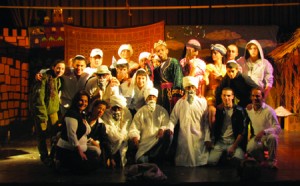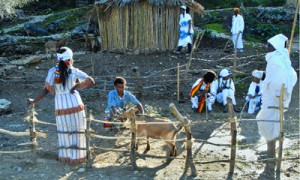Israeli Scene
Feature
Sigd’s Teachable Moment
Esther Beych’s eyes light up and her smile widens when she remembers her best friend—a classmate from Russia—tasting injera bread for the first time.

Courtesy of Manu Har Sinai/Hadassah Neurim.
“She loved it,” said Beych, 17, a student at Hadassah Neurim Youth Aliyah Village, on the coast near Netanya. “She was surprised by the flavor.” Beych, who made aliya from Ethiopia as a toddler with her parents and seven older siblings, grew up eating injera, the wholesome Ethiopian flatbread that tastes like fermented sourdough. Made with the high-protein, high-fiber, iron-rich, low-gluten grain called teff, it is far more nutritious than pita. Beych had never thought of offering it to her non-Ethiopian classmates until she was among the Ethiopian students and staff preparing a village-wide dinner as part of an extended, three-day post-Sigd festival at Hadassah Neurim. Sigd, a holiday celebrated previously only by the Jews of Ethiopia, became an official Israeli holiday in 2008. The holiday comes 50 days after Yom Kippur.
Celebrating Sigd in an elaborate way at Hadassah Neurim is part of a strategy by village staff to instill Ethiopian students with pride in their ethnic roots. Back in Ethiopia, teens didn’t have adolescence as we know it,” said Manu Har Sinai, who conceived the post-Sigd celebration. He is in charge of residential education at the village and the yearly Sigd activities. “Ethiopian Jewish teens were often married by 13 in order to protect them from demands by non-Jewish neighbors to marry their children. Here, their parents aren’t sure how to react to freethinking young people. The kids often identify with American blacks or want to be Bob Marley.
“Strengthening their respect for Ethiopian culture is critical for their healthy development.
“But there’s a second aspect to the way our program is structured,” Har Sinai added. “We want our teens to appreciate their [and their] parents’ culture—which is easy for them to dismiss as old-fashioned and out of sync with modern Israel.”
Feeling good about one’s customs and traditions is essential for self-esteem and the ability to take one’s place in Israeli society, insisted Natan Biton, director of Hadassah Neurim, where 40 percent of students come from Ethiopian backgrounds. Most of the teens were born in Israel or, like Beych, arrived as small children with little memory of life abroad.
Long before the Ethiopians arrived, as early as the 1920s, rural youth villages were established in prestate Israel as idealistic models of democratic education.
In Youth Aliyah, Henrietta Szold found refuge for teens fleeing Nazi Germany; the villages were ideal venues for child rescue, offering housing and high school. After World War II, the villages became home to young Holocaust survivors. Later, they were opened to immigrants from Morocco, Romania, Iraq and almost every other immigrant group as well as sabra children from impoverished and dysfunctional homes.

tukuls at the Youth Aliyah village. Courtesy of Lilach Im/Meir Shfeya.
In recent decades, most immigrants have come from the former Soviet Union and Ethiopia. On the advice of social workers and counselors, native-born Ethiopian children often elect to study in these residential settings because of the challenging socioeconomic situations at home.
Hadassah was a pioneer in helping to establish Youth Aliyah and the 60 villages that still care for teens throughout the country. Today, Hadassah continues to support Hadassah Neurim, Meir Shfeya Youth Village and, to a lesser degree, Ramat Hadassah Szold, near Kiryat Tivon, east of Haifa.
Director Biton understands the cultural challenges immigrant children face because of his own life experience. “My family came from Morocco, and I loved Middle Eastern music,” he said. “I can remember listening secretly to the cassettes, afraid neighbors would hear me and think less of me because I liked [that kind of] music. It took me a long time to embrace my own identity.”
His parents could not speak or read Hebrew and could not help shepherd him through the no-frills Israeli school system, but Biton and his five siblings all excelled academically and earned graduate degrees.
“We want our students to understand that no culture is superior to their own,” Biton said. “That’s the message Sigd sends.”
When they lived in Africa, Ethiopian Jews celebrated Sigd by fasting, dressing in festive white clothing and climbing the highest nearby mountain peak (reminiscent of the gathering at Mount Sinai) where, facing Jerusalem, they reaffirmed their acceptance of the Torah and their longing for Jerusalem through prayer and reading the Torah.
In the afternoon, they returned to their villages for feasting and dancing. Traditionally, it is thought that the holiday originated in the days of Ezra and Nehemiah, in the fifth century B.C.E., at the time when all Jews assembled in Jerusalem and, by fasting and confessing, made a covenant with God to uphold the Torah (Nehemiah, Chapters 9-10).
Since Sigd became an official Israeli holiday, thousands of celebrants come to Jerusalem each year to hear Ethiopian rabbis (kessim) chant prayers and read from the Torah.
Students from the youth villages travel to Jerusalem to celebrate as well. But in recent years, Hadassah Neurim’s home-grown post-Sigd festivities have helped the students take ownership of the holiday and instilled them with pride. In 2010, for instance, on the Friday night after the Jerusalem ceremony, more than 300 residential students and staff members sat down to eat an Ethiopian Shabbat dinner: doro wat, a spicy chicken stew with red pepper paste; dabo, thick honey bread; and a lot of injera, the national dish.
“I felt really good that our food and culture were appreciated,” said Beych. “We often get a feeling that other Israelis know so little about Ethiopian traditions that they assume we have none or that they’re of little value. The festival gives us a chance to show off a little bit to our fellow students and teachers.”
Each year’s festival at Hadassah Neurim includes a dramatic production adapted from an Ethiopian folktale; students from every ethnic background take part in the Friday night play. In last year’s performance, a lion wants to marry a beautiful young woman, and at the insistence of the girl’s father, the lion cuts off all his lion hair to fit into the family. That’s not good enough, so he trims his claws. Later, the lion files his sharp teeth and, finally, he cuts off his tail. But then his putative father-in-law rejects him: He doesn’t want a son-in-law who doesn’t have enough character to feel proud of who he is.
Sigd at Hadassah Neurim ends with a country fair re-creating life in Ethiopia. At one booth, students reenact the Ethiopian equivalent of a coffee klatch: the Buna ceremony. Coffee is roasted, pulverized, boiled and then dramatically poured into tiny glasses when held high. But the most important part is the talk.
At Buna, the women of the rural community used to discuss their families and personal issues, gleaning advice from contemporaries and older women. At another booth, dexterous teens demonstrate the art of hair plaiting, copied in expensive salons today in Israel. Everyone takes part in the joyful dancing, learning elaborate traditional shoulder movements to the music of internationally acclaimed Ethiopian pop stars like Aster Aweke and Gigi Shibabaw.
Hungarian-born Har Sinai likes to point out the beauty of Ethiopian Jewish culture to his students. On his desk is a book of Ethiopian proverbs translated into Hebrew, which he quotes when counseling them to seize the future: “A house can’t be built for the rainy season that is past.” Or “Little by little an egg will walk.”
“I remind my students,” he said, “that they are the result of nearly 3,000 years of history, from the time King Solomon, the wisest man in the world, married the brilliant and beautiful Queen of Sheba. I ask them if they want to be the first generation to break the tradition. I’m not talking only about food and customs, but the respect shown to parents and the soft-spoken manners that characterized this unique community. Today, many of the students feel they have to hang tough and to take on the local chutzpa.”
Further north, a third of the 270 boarding students at Meir Shfeya Youth Aliyah Village come from Ethiopian backgrounds.
Yoram Penias, Meir Shfeya’s director, initiated a different approach to express appreciation for Ethiopian Jewish roots. Last year, the students and staff built an authentic Ethiopian village on the hillside next to the village dairy. Five circular mud huts, called tukuls, were raised near the village’s experimental farm. Goats, free-range chickens and geese wandered among them.
Students and staff gathered building materials from the area, then followed traditional tukul construction methods.
First they drew a circle on the ground, then eucalyptus poles were placed at intervals along the circumference. Last, the center post was set, tall enough to give the roof an angle of at least 50 degrees. The walls were filled with upright poles stuck in the ground, set close together and tied with rope. The roof was made of wood and grass, the walls plastered with straw and mud from the Meir Shfeya cowshed.
In the center of three tukuls is a hut, the synagogue, with a Star of David on the roof. At a distance is another tukul, where women went for seclusion and rest after they gave birth.
Penias has made the outpost a modest tourist attraction, with students giving tours to occasional visitors interested in the distinctiveness of Jewish Ethiopian life.
Benny Amara, 18, was a high school senior when he worked on the project. He was often busy explaining to fellow students, among them native-born Israelis, Druze and Russians, how families in Ethiopia divided the living space in their tukuls. Even though he was born in Ethiopia, he only understood about his parents’ and grandparents’ homes after he became part of the building crew.
“I came to Israel when I was 5,” recalled Amara, now a soldier in the Israel Defense Forces, “so I had to consult my mother and grandmother about life in the old country. The stories they sometimes told about their lives in Ethiopia took on new meaning.”
While they were building the village, Amara’s mother gave birth to a baby. He realized that if she were living in an Ethiopian village, she would have moved to the women’s hut.
“That hut elicited a lot of curious questions from my friends,” Amara said. “But I learned from my grandmother and mother that the women enjoyed going there after giving birth. The other village women helped them and they had a chance to recover without the pressures of home life.”
When the village opened last year, the story was featured on television—and Amara’s mother and grandmother saw the story and cried with a mix of nostalgia and pride in his efforts.
Said Penias, “We talk a lot with the kids about their future, but you can’t grow a strong trunk and strong branches without roots.”








 Facebook
Facebook Instagram
Instagram Twitter
Twitter
Leave a Reply